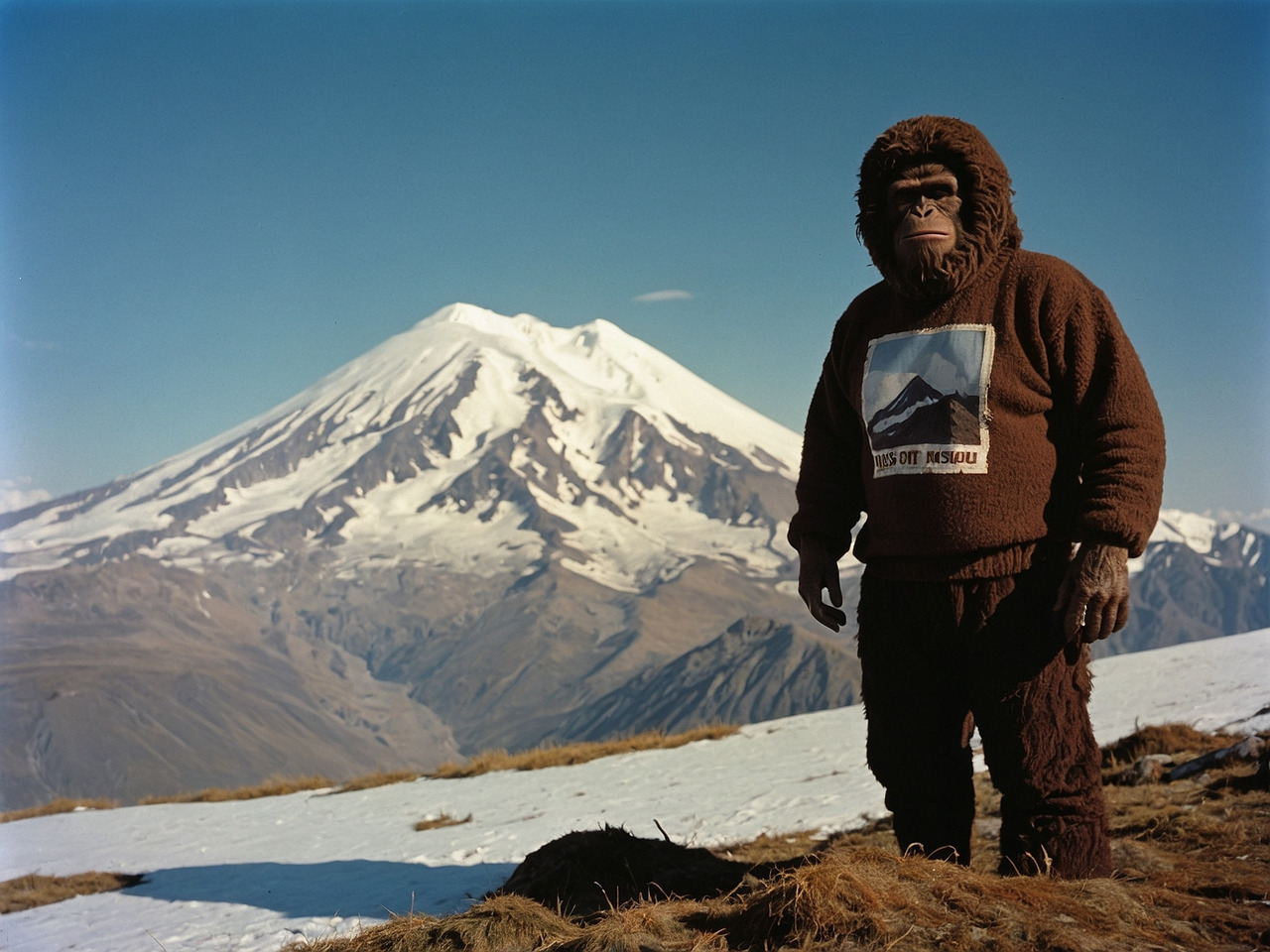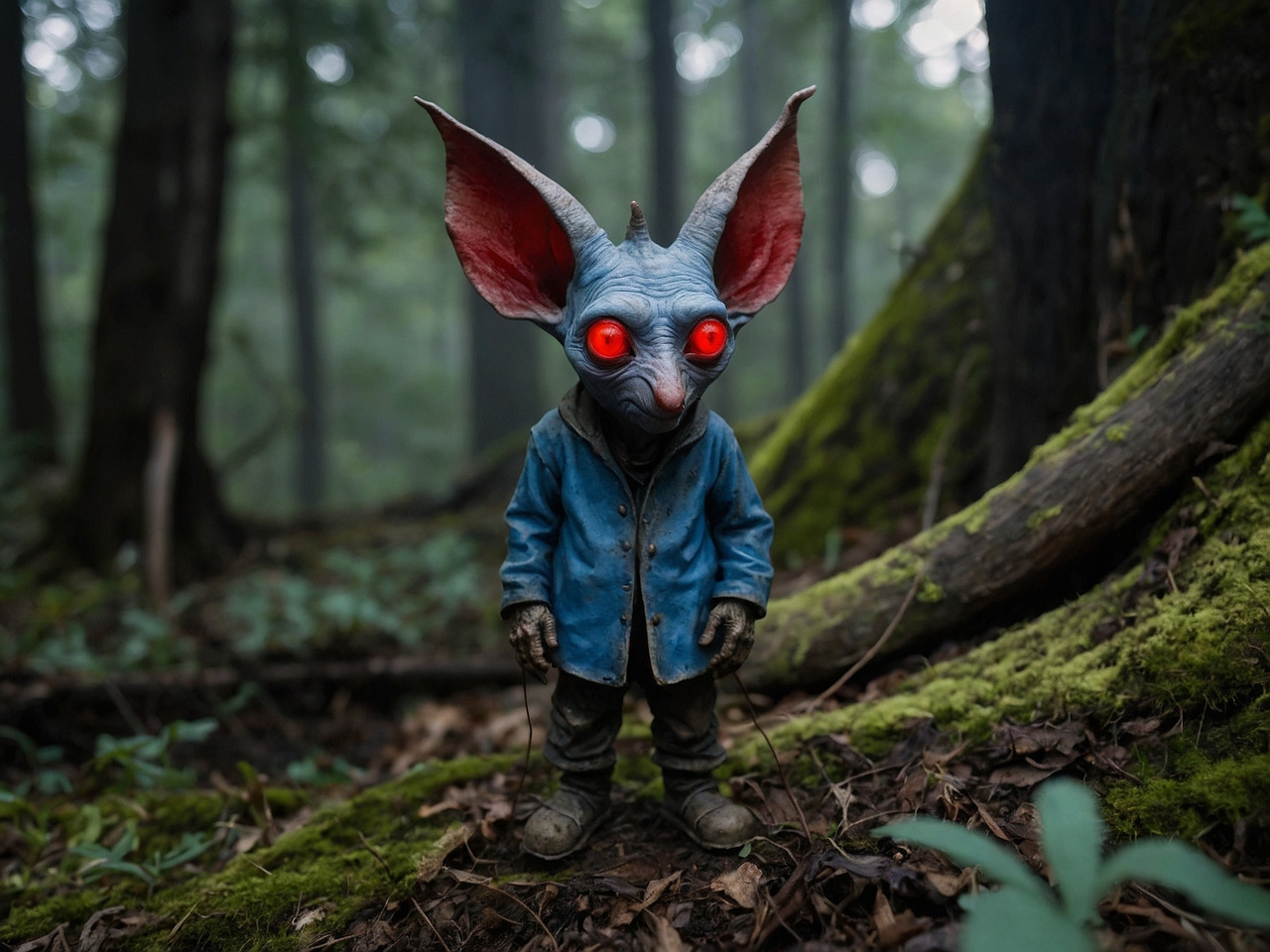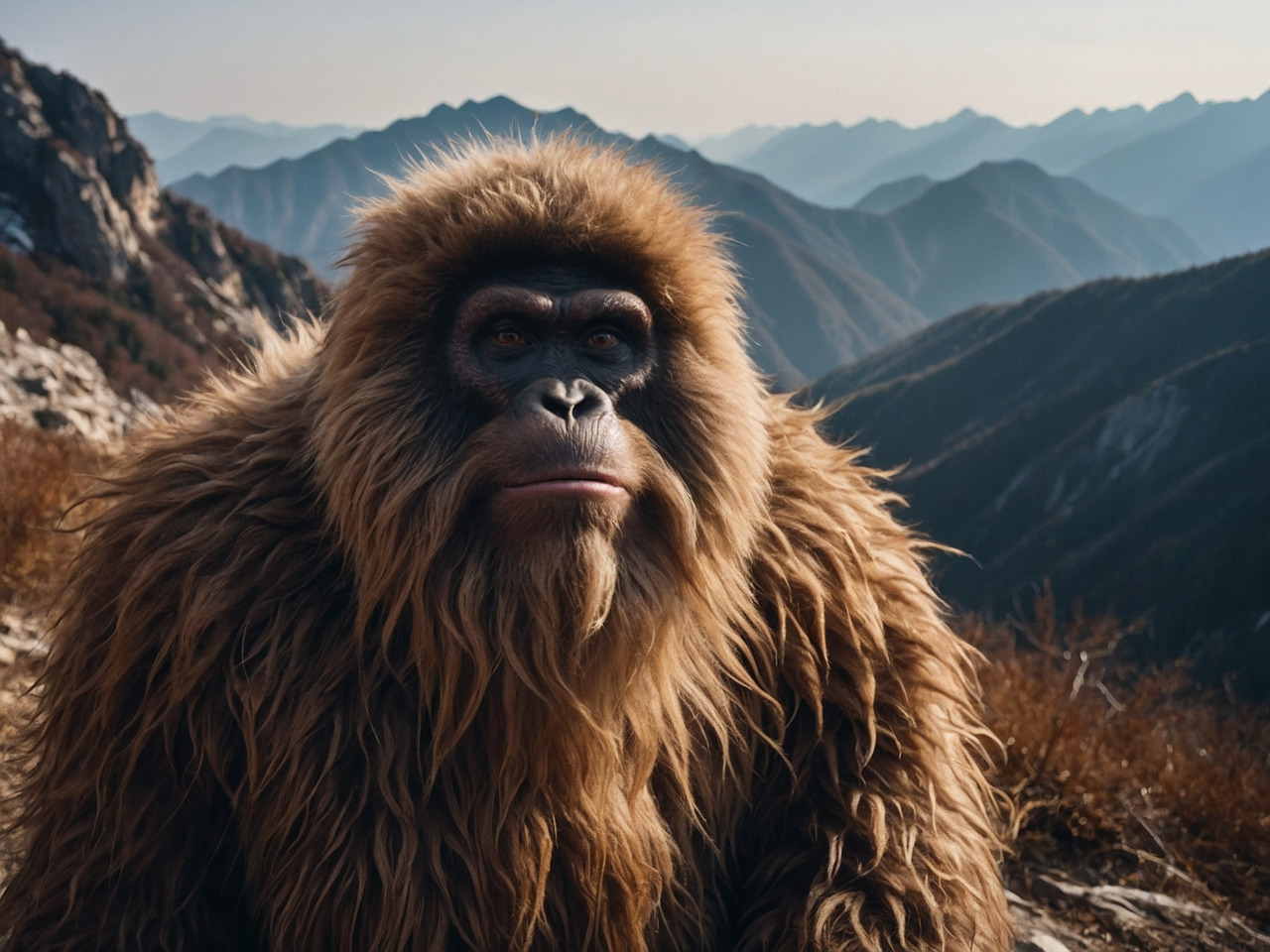
Бесплатный фрагмент - Monster hunting
CONTENTS
Agach-kishi
Gulyabani
Sukijavrey Chupche
Girona Gnome
Yeren
Zana of Tkhina
Yowie
Bunyip
Popobawa
Grey Man
Mothman
Monkey Man
Owlman
Lizard Man
Black-eyed children
Chuchuna
Kyshtym dwarf Alyoshenka
Bigfoot
Dingonek
Chupacabra
Yeti
Almasti
Proem
The jungle breathed. Hot, humid air, thick with the scent of decaying vegetation and something indefinably feral, clung to me like a sticky web. Every rustle, every snap of a twig under the weight of some unseen creature sent my heart hammering against my ribs. I trudged on, sinking into the swampy ground, hacking through thorny vines, driven by a single, obsessive goal — to find them. The monsters whispered about around campfires, the creatures whose names are spoken with trembling voices, the stuff of myth and legend.
The mountains, cold and unforgiving, were my next ordeal. Icy winds lashed at my face, and the crunch of age-old snow echoed beneath my boots. It was at night, when the temperature plummeted and a deathly silence descended, that the true horror began. From the inky blackness came unearthly sounds — a long, drawn-out howl, the scrape of claws on rock, a heavy, ragged breathing. My blood ran cold. Several times I thought I saw them — two burning red eyes staring back at me from the impenetrable darkness. In those moments, I was paralyzed with terror, unable to move, unable even to scream. Fear, cold and viscous, choked the will out of me, constricting my throat in an iron grip.
This was no scientific expedition. It was a descent into the abyss, a journey to the darkest corners of the planet and of the human psyche. I searched for monsters without, but I found them within. This journal is a chronicle of my descent into madness, a testament to the fact that reality is far more terrifying than any fiction. If you dare to read on, be prepared for the line between myth and reality to blur, and for something to stare back at you from the darkness… the eyes… the eyes of things best left unspoken.
Agach-kishi
The wind, sharp with the scent of pine and the icy breath of Elbrus, whispered ancient tales. It rustled through the gorges, tumbled down the rocky slopes, reaching the ears of shepherds, hunters, and all who dared to listen to the voice of the mountains. One of the most unsettling narratives is the story of the Agach-kishi, the forest people, whose existence is shrouded in a veil of mystery and fear.
They are children of the twilight, born of the age-old forests where sunlight is a rare visitor. Their bodies are covered in thick, matted hair, the color of dried leaves and moss. Their faces, contorted in a grimace of perpetual hunger, vaguely resemble human features, but their bestial nature is evident in their low, sloping foreheads and deep-set eyes, burning with an unsettling fire. A sharp, animalistic odor emanates from them, a smell of wild beast and decaying earth, a smell that, once encountered, is never forgotten.
By day, the Agach-kishi hide in the impenetrable thickets, in the hollows of giant trees, in dark caves where even echoes fear to whisper. But with the onset of night, when the moon carves a silver sickle through the inky blackness, they emerge from their lairs. Hunger drives them towards human settlements. Under cover of darkness, silent as shadows, they steal towards gardens and orchards. And here, a strange, disturbing peculiarity of these creatures manifests itself: they don discarded human clothing. Tattered shirts, worn trousers, hole-ridden shoes — everything that humans have rejected becomes for the Agach-kishi a semblance of a mask, a pathetic parody of humanity. This contrast — the wild, animalistic essence hidden beneath the rags of civilization — evokes a primal terror, chilling the blood in the veins.
The elders say that an encounter with the Agach-kishi is a bad omen. They are the embodiment of wild nature, hostile to humans, a reminder of the ancient, dark forces that lurk in the depths of the mountains. And while no one can say for certain whether these creatures are real or merely a figment of the imagination, the fear of them lives in the hearts of the mountain people, passed down from generation to generation, whispered in hushed tones, accompanied by the howling wind in the mountain gorges. Every rustle in the night’s stillness, every indistinct silhouette in the moonlight, serves as a reminder of them — the Agach-kishi, the forest people, lost between the world of beasts and the world of men.

*****
The wind whipped viciously at my face, carrying shards of icy rain. Mount Elbrus, shrouded in a misty veil, loomed silently above me, like an ancient god indifferent to my paltry search. I had been in these cursed mountains for a week, chasing the phantom hope of finding the Agach-Kishi — a legendary creature, half-man, half-ape, rumored to roam these woods, clad in the tattered remnants of human clothing.
Night fell swiftly, like a predator stalking its prey. I made a small camp at the foot of the mountain, near the edge of the forest. The fire crackled, casting dancing shadows on the tree trunks, transforming them into grotesque monsters. Suddenly, through the crackling flames, I heard it — a low growl that made my hair stand on end. My heart hammered in my chest like a trapped bird. Grabbing my flashlight, I plunged into the woods, the source of the sound drawing me deeper into the trees.
The beam of my flashlight danced across the trees, their gnarled branches like clawed hands reaching out from the darkness. The growling grew closer, more distinct. Suddenly, I saw it. A large, hunched figure was rummaging through a pile of rubbish left by tourists. It was draped in rags that barely covered its powerful frame. This was it! The Agach-Kishi!
With a cry of triumph, I rushed forward, but at that very moment, the creature turned sharply, illuminated by my flashlight. My triumphant cry died in my throat. It wasn’t the Agach-Kishi. It was a man. An ordinary homeless man, scavenging for food in the discarded refuse. His face, gaunt and grimy, was contorted in a mask of terror at the sight of me. He yelped and bolted, vanishing into the darkness.
All my excitement evaporated, leaving only emptiness and a vague sense of shame. I stood alone in the dark forest, surrounded only by the rustling leaves and the cold wind. And somewhere out there, in the impenetrable darkness, perhaps the real Agach-Kishi lurked, watching me with burning eyes.
Gulyabani
The wind, whipping across the barren slopes of the Pamirs, whispered tales born in the heart of the mountains. Tales of beings hidden from sight, yet whose presence was felt in every gust of icy wind, in every rustle of dry grass. One such tale speaks of the Gulyabani, a fearsome denizen of the desolate highlands.
It was said to roam the solitary places, where the rocks clawed at the sky and the silence pressed down upon the ears. The Gulyabani — a creature of immense size, human-like, yet distorted, as if viewed in a warped mirror. Its body was covered in thick, coarse fur, the color of ash or the darkness of night. A heavy, nauseating odor emanated from it, the smell of a wild beast, a smell that clung to clothes and hair, lingering for days. But the most horrifying feature of the Gulyabani was its backward-turned feet. The tracks it left in the earth were a perverse reflection of human footprints, a symbol of the unnatural, a sign that made the blood run cold.
Sometimes, under the cover of twilight, the Gulyabani would appear to people. Its voice, unexpectedly human, would shatter the silence, issuing a challenge to wrestle. This was not merely a contest of strength; it was a trial, a test of the spirit. The elders whispered that to accept the Gulyabani’s challenge was to defy fate itself. To defeat it was nearly impossible, its strength inhuman, and the loser was doomed to wander the desolate mountains for eternity, in the company of shadows and winds.
Yet, there were those who dared to accept the challenge. Legends tell of brave souls who, armed not only with physical strength but also with cunning, courage, and faith in their ancestors, managed to outwit the Gulyabani, avoiding the contest or even forcing it to flee. These stories, passed down through generations, became symbols of hope, proof that even in the face of the most terrifying horror, the human spirit could find a way.
Thus, woven into the fabric of Pamir folklore, the image of the Gulyabani became not just an embodiment of fear, but also a reminder of the strength of the human spirit, of the ability to resist darkness, of the eternal struggle between humanity and the wild. And as the wind whispers its tales, the legend of the Gulyabani lives on, terrifying and inspiring in equal measure.

*****
The Pamirs. Mountain ridges, like skeletal fingers of giants, clawed at the sky. The air, thin and icy, burned my lungs. A silence, deep and ominous, pressed against my eardrums. I walked, haunted by the specter of Gulyabani, that nightmarish reflection of humanity, the creature whose name is whispered in hushed tones by the locals. The smell. That cursed smell pursued me, clinging to my clothes, my hair, my very skin. A heavy, nauseating stench of wild animal mingled with something sweet and putrid. The smell of Gulyabani.
Every step was a struggle. The bone-chilling wind howled through the ravines like a madman. But I pressed on, driven by the obsessive need to find this creature. To find it and prove to the world that nightmares can be real.
And then… on the rocky ground, amidst the sparse vegetation, I saw them. Tracks. Unmistakable. The backward-facing feet, a twisted mockery of human anatomy. A symbol of the unnatural, the mark of Gulyabani. My blood ran cold. My heart hammered against my ribs. Fear, and a strange, inexplicable excitement, washed over me.
I followed the tracks, my eyes glued to the ground. They led me upwards, along a steep slope, towards the edge of a precipice. The wind intensified, trying to tear me from the mountainside. The smell of Gulyabani became overpowering, making me gag. And then… the tracks stopped. Simply vanished at the very edge of the abyss. I approached cautiously, peering over the edge. My head swam. Before me was a sheer drop, plunging into an immeasurable darkness. No tracks, no sound. Only the wind and that damned smell, which now seemed to emanate from the chasm itself.
What happened to Gulyabani? Did it jump? Fly? Dissolve into thin air? Questions swarmed in my mind, but there were no answers. Only emptiness and a viscous, primal dread crawling down my spine like icy fingers. I stumbled back from the edge, my knees trembling uncontrollably. Gulyabani was gone, but its presence lingered, hanging in the air, on the very edge of reality, on the precipice of madness.
Sukijavrey Chupche
The wind, a relentless sculptor of ice and snow, carries whispers across the tundra. Whispers of a creature both feared and fascinating, a being woven into the very fabric of the harsh northern landscape: the Sukijavrey Chupche. Not only the Yukaghir, children of the tundra, but even the northern Yakut, whose lives are intertwined with the icy breath of the Arctic, believe in its existence.
They speak of a wild figure, cloaked in thick, coarse hair, blending seamlessly with the muted browns and greys of the frozen plains. Its speed is legendary, a blur against the endless white expanse, its passage marked only by a haunting, high-pitched whistle that cuts through the howling wind. This whistle, a chilling serenade, is said to precede the disappearance of food stores and, more ominously, the vanishing of women. The Sukijavrey Chupche is a thief, not of material possessions, but of the very essence of survival — sustenance and progeny.
The stories paint a picture of a creature both bestial and cunning. Its motivations remain shrouded in mystery, fueling speculation and fear. Some believe it to be a malevolent spirit, a personification of the tundra’s harsh realities. Others whisper of a more tangible explanation, a hypothesis as bold as the icy landscape itself. They speak of sea hunters from the far Northeast, adrift on fractured ice floes, carried by capricious currents far to the west, to the mouths of the Kolyma and even the Indigirka. Lost and desperate, these castaways, transformed by hardship and isolation, become something other, something more primal. Their once-human forms adapt to the unforgiving environment, their skills honed for survival, their appearance altered by the relentless wind and cold.
This hypothesis adds a layer of tragedy to the legend of the Sukijavrey Chupche. Are they monsters, or merely men, driven to extremes by the cruel hand of fate? The question hangs in the frozen air, unanswered, echoing the loneliness of the vast tundra. The whistling wind becomes a lament, a mournful cry for those lost in the icy wilderness, a reminder of the fragility of human existence in the face of nature’s overwhelming power. The legend of the Sukijavrey Chupche serves not only as a cautionary tale but also as a testament to the enduring human spirit, capable of both great resilience and profound desperation in the face of unimaginable hardship.

*****
The wind, laced with needles of ice, sliced at my face. The endless white expanse of the tundra stretched to the horizon, bleak and lifeless. I had come to the far north, drawn by unsettling rumors of missing women. The locals whispered of the Sukijävri Chupacabra — a hairy demon, swift as the wind, whose prey was not only women but also food stores, dooming entire families to starvation.
Tracks in the snow — strange, unlike those of any known creature — led me deeper into the icy wasteland. They appeared abruptly, vanished just as suddenly, as if the creature moved in leaps and bounds, defying the laws of physics. The frost seeped into my bones, but I was warmed by the feverish thought of an imminent encounter with the unknown.
And then, through the howl of the wind, I heard it. A piercing, whistling sound that made my blood run cold. The same whistle the hunters spoke of, the whistle that presaged disaster. It was close, very close. My heart hammered in my chest. I ran, stumbling over the uneven frozen ground, my eyes fixed on the tracks, which were now very near.
The whistle grew louder, more piercing, it practically tore at my eardrums. I saw it! A dark, blurred silhouette racing across the snow with incredible speed. The Sukijävri Chupacabra! I was so close!
Suddenly, a sharp pain shot through my head. I fell, collapsing into darkness. The last thing I remember is that piercing whistle, as if it were drilling into my brain.
I awoke in a chum, surrounded by the worried faces of hunters. They had found me unconscious in the tundra. They said I was lucky to be alive. They didn’t know what had attacked me. But the whistle… that damned whistle still rings in my ears, a reminder of an encounter with something incomprehensible, something terrifying, lurking in the icy wasteland.
Girona Gnome
The whispers started in the autumn of ’89, carried on the crisp Tramuntana wind that swept down from the Pyrenees. They spoke of something strange, something unsettling, found in the woods near Girona, a creature that defied explanation and ignited the fires of imagination. They called it the Girona Gnome.
September’s sun, still warm on the skin, dappled the road between Banyoles and Olot as two picnickers strolled, their basket laden with bread, cheese, and wine. A faint, keening sound, like the mournful sigh of a lost child, drew them from the path, deeper into the emerald embrace of the woods. There, amongst the fallen leaves and whispering pines, they saw it. A fleeting glimpse of azure skin, no larger than a man’s hand, scrambling for cover.
The creature, barely twelve centimeters tall, possessed an otherworldly fragility. Its skin, a smooth, unsettling blue, was mottled with darker patches around its face and neck. Crimson eyes, startlingly large in its tiny head, stared out from beneath a pair of elongated, almost vulpine ears. A delicate, rodent-like nose twitched nervously. Webbed membranes, thin and translucent, stretched between its slender digits. And that sound — a high-pitched squeak, like the brittle cackle of an ancient crone — continued to pierce the quiet of the woods.
With a blanket, they gently captured it. For a day, perhaps longer — accounts vary, blurring the edges of memory with the fantastical — the creature remained their captive. It refused all sustenance, its ruby eyes fixed on some distant, unseen horizon. Despite its diminutive size, it seemed to possess an unnerving intelligence, a silent awareness that transcended its physical form. Then, as swiftly as it had entered their lives, it was gone.
A Spanish parapsychologist, drawn by the whispers of the extraordinary, acquired the tiny corpse. Preserved in formaldehyde, a silent testament to the unknown, it became the subject of intense scrutiny. Photographs, grainy and ethereal, surfaced, capturing the world’s attention. John Altschuler, an American scientist, and Dr. Luis Linares, a Spanish physician, examined the remains. Their verdict: genuine, yet unclassifiable.
Was it a grotesque twist of nature, a teratological anomaly riddled with pathological abnormalities? Or, more tantalizingly, was it a glimpse into a hidden world, a previously unknown species, a testament to the boundless diversity of life?
The Girona Gnome remains an enigma, a whisper in the wind, a question mark etched into the landscape of the strange. Its existence, fleeting and mysterious, continues to haunt the fringes of scientific understanding, a reminder that the world still holds secrets waiting to be unveiled, secrets that challenge our perception of reality and ignite the flames of wonder.

*****
The Catalan forests held their silence, thick and impenetrable as pitch. The air, heavy with the scent of pine and damp earth, felt viscous, clinging. For days I’d wandered these woods, a lost soul driven by the obsessive need to find the Girona gnome. A single eyewitness account, a blurry photograph — that was all I had. But I believed. If it had been seen once, it existed. And if one existed, there could be others.
The sun had long since set, leaving behind only the ghostly light of dusk. The forest had transformed, becoming ominous and threatening. Every rustle, every crack of a branch sounded like a warning. I pushed through the deepening shadows, catching on thorny bushes, when my gaze fell upon something… unusual.
A small cave, hidden beneath an overhanging rock, seemed to pulse with a faint light. I approached cautiously, my heart pounding against my ribs as if trying to escape. Inside the cave, a fire danced on a crudely built stone hearth, casting bizarre shadows on the walls. And around the fire… there they were.
Small, no taller than a child, they were creatures with long beards and pointed ears. Their skin was the color of earth, and their eyes gleamed in the half-light like tiny embers. They wore rough clothing made of hides and leaves. One held something gleaming — a golden goblet, encrusted with jewels. Noticing me, the gnomes froze, their eyes fixed on me with undisguised curiosity and… wariness. One let out a piercing whistle, and in an instant, they were gone, vanished into thin air. Only the smoldering fire and the golden goblet, lying on a stone, remained.
With trembling hands, I picked up the goblet. It was heavy, cold, and… real. In that moment, I knew I had found something incredible, something that would change the world. But with that realization came fear. Fear of what this forest concealed, fear of what I had awakened. I was no longer the hunter. I had become the prey.
I turned to return to my camp, but then I caught a strange scent, sweet and intoxicating, like fermented fruit. It hung in the air, enveloping me, seeping into my lungs. My head began to spin, my thoughts became muddled, and my legs grew weak. The world around me swam, colors faded, sounds became muffled, as if I were sinking to the bottom of a deep lake. The last thing I remember is a feeling of incredible lightness, and then… nothingness.
Waking was abrupt and painful. I opened my eyes to a gray, overcast sky. My body ached, my head throbbed as if a bell were ringing inside it. I tried to sit up and discovered, with horror, that I was completely naked. Around me was only damp earth and stunted vegetation. I didn’t understand where I was or how I had gotten there. The memories of the previous night were blurred and indistinct, like a dream.
I shivered. The cold pierced me to the bone. I tried to remember what had happened, to reconstruct the chain of events, but there was only fog in my mind. Suddenly, the image of small, stocky figures flitting through the forest surfaced in my memory. Gnomes? Had I really met them? Or were they hallucinations brought on by that strange smell? I didn’t know what to believe. Reality and fiction were so intertwined that I could no longer distinguish one from the other. Fear, dull and viscous, began to rise again from the depths of my soul. I was alone, naked, and helpless in the heart of the wild mountains, and I felt as if unseen eyes were watching me from behind every tree, from behind every stone.
Yeren
The mists that shroud the remote peaks of Hubei Province hold secrets whispered for centuries. These whispers tell of a creature that walks upright, yet is not human; a being that echoes both the familiar and the utterly alien — the Yeren.
For generations, tales have been spun around flickering fires, tales of a hulking figure glimpsed through the dense foliage. Towering between six and eight feet tall, some say even ten, the Yeren is a behemoth cloaked in long, shaggy fur, most often a deep russet or dark brown, though whispers persist of sightings of a spectral white coat. Its hair, a thick, coarse mane, hangs several inches long, framing a face that sits uneasily between ape and man — flatter, more primal, yet unsettlingly humanoid. Long, powerful arms dangle almost to its knees, while its legs, though built for bipedal movement, hint at a capacity for swift, quadrupedal bursts of speed, evidenced by the deep, elongated, almost ape-like tracks it leaves behind — tracks over forty centimeters long, rounded at the toe as if designed for climbing and running. These prints, five-toed yet simian in shape, tell a silent story of a creature at home in the vertical world of the forest.
The Yeren’s voice, when heard, is a chilling counterpoint to the usual symphony of the wilderness. A sharp, piercing cry, it echoes through the valleys, a sound that speaks of both power and something profoundly other. While local lore paints the Yeren as a fearsome predator, some scholars within the hallowed halls of the Chinese Academy of Sciences, who entertain the possibility of its existence, theorize a more benign dietary preference: berries, nuts, insects, and the occasional raid on a village cornfield. They envision the Yeren living in mated pairs, sometimes in small family groups, a hidden community mirroring our own, yet existing just beyond our grasp.
Since 1920, over four hundred reported sightings have been meticulously documented by Chinese authorities, each adding another layer to the enigma. Some cryptozoologists draw a tentative line between the Yeren and the extinct Gigantopithecus, a colossal ape that once roamed these very mountains. Others, venturing further into the realm of speculation, propose that the Yeren is a relic hominid, a forgotten branch of our own family tree, stranded in an evolutionary cul-de-sac. Still others, clinging to a more conventional scientific framework, suggest a new, undiscovered species of orangutan.
But regardless of its true nature, the Yeren remains a potent symbol of the untamed wilderness, a reminder that even in the 21st century, mysteries still lurk in the shadows, waiting to be unveiled. The whispers in the mountain mists continue, a testament to the enduring power of the unknown, the enduring allure of the Yeren, the wild man of Hubei.

*****
In the western reaches of Hubei, amongst the densely forested mountains, the air hangs thick and humid, saturated with the scent of pine and damp earth. Here, in a realm of perpetual shadow, I searched for Yeren — a creature whispered about by locals, described as a giant, hairy figure that roamed the remote valleys. Days blurred into an endless cycle of ascents and descents, every rustle, every snapping twig filling me with a nervous anticipation.
Then, at dusk, as the sun dipped behind the mountain peaks, painting the sky in hues of blood-red, it happened. A flash of reddish-brown, something enormous, moved through the bamboo thicket. My heart stopped, then began to race uncontrollably. Yeren!
Without a moment’s hesitation, I plunged after it, pushing through thorny bushes, scratching my face and arms. The creature moved with incredible agility, leaping from branch to branch like a giant, rust-colored squirrel. I managed to snap a few photos, my fingers trembling with excitement. The frame captured a powerful, hairy back, long arms that hung almost to the ground. In one photo, I even glimpsed its face — flat, with deep-set, black eyes that seemed to pierce my very soul.
The pursuit lasted for nearly an hour. I was close, so close to obtaining irrefutable proof of Yeren’s existence. But then, my path was blocked. Men in uniform. Chinese army. Or police. I couldn’t tell.
They were abrupt and unfriendly. Without a word, they confiscated my phone, examined the photos and videos, and then, without a single explanation, wiped everything. I was bundled into a jeep and driven to the nearest town. The entire journey they tried to convince me that I had seen nothing but a large, reddish-brown monkey, that Yeren was nothing more than a myth. But I knew what I saw. I saw Yeren. Its eyes… I will never forget those eyes. And I will be back.
Zana of Tkhina
The whispers began in the shadowed valleys of Abkhazia, carried on the mountain winds — tales of a creature, neither beast nor human, haunting the slopes of Mount Zaadan. They called her Alma, the forest woman, a being of myth and nightmare. Then, in the latter half of the 19th century, the whispers solidified into a story, a story of capture, of a wildness tamed, and a life lived on the fringes of humanity.
Prince Achba, on a hunting expedition, stumbled upon the legend made flesh. Zana, they named her, a towering figure, two meters tall, her body a tapestry of dark brown hair, thickest at her legs and loins. Her skin, a dusky grey, peeked through the matted covering. Her face, too, bore a mantle of hair, though shorter, framing eyes that burned with a primal, red fire. A broad, flat face, a sloping forehead, a wide mouth, and a prominent jaw — features that spoke of a lineage far removed from the people of the valley.
Бесплатный фрагмент закончился.
Купите книгу, чтобы продолжить чтение.